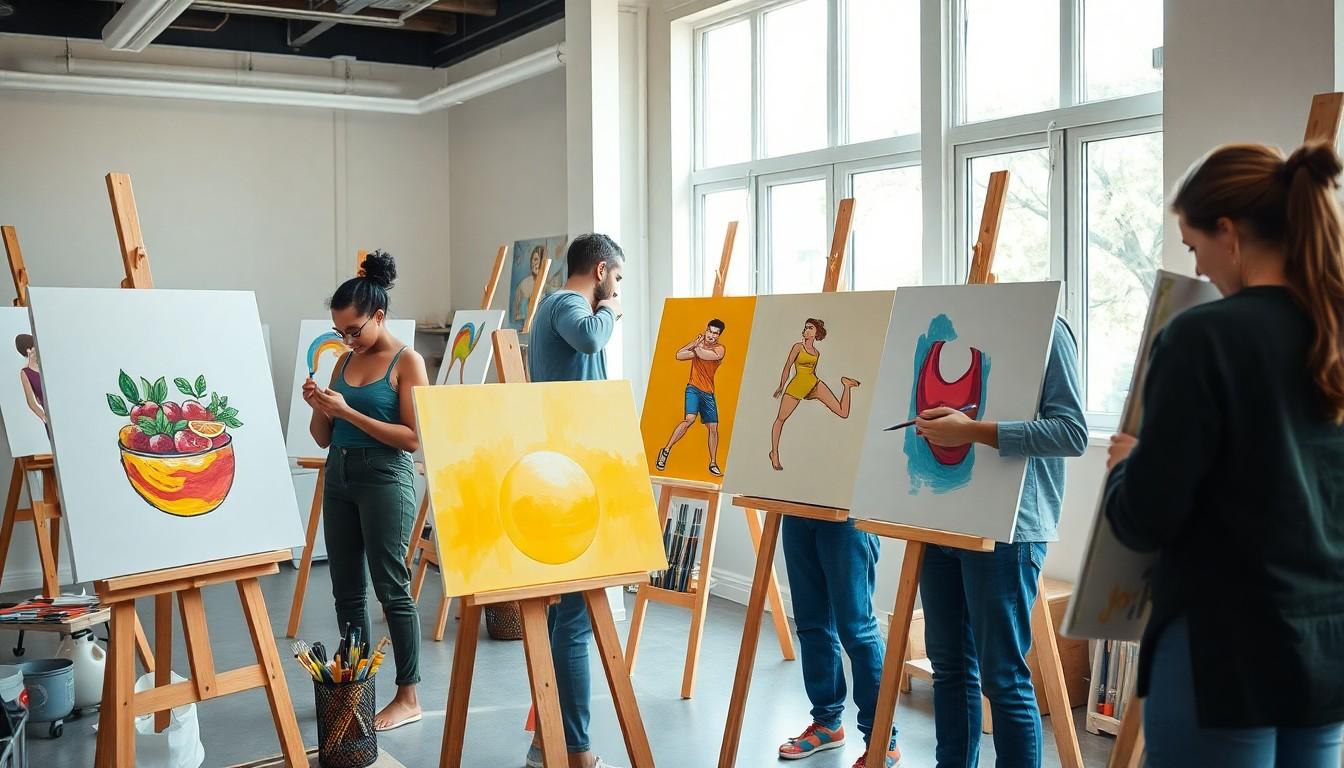Imagine a world where staying fit and healthy is as easy as doodling on a napkin. Enter physical health drawing—an innovative blend of art and wellness that’s not only engaging but also downright fun. It’s like exercise for the mind, where creativity meets the quest for a healthier lifestyle.
In a society obsessed with gym selfies and kale smoothies, physical health drawing offers a refreshing twist. It encourages individuals to visualize their fitness goals, track their progress, and express their journey in a way that’s uniquely personal. Whether one’s sketching a vibrant plate of veggies or illustrating a yoga pose, this artistic approach transforms health aspirations into a colorful narrative. So grab those colored pencils and get ready to draw your way to better health—because who said fitness can’t be a masterpiece?
Understanding Physical Health Drawing
Physical health drawing merges art with wellness, making it an engaging way to focus on fitness. This creative approach allows each person to explore their health journey visually.
Definition and Importance
Physical health drawing represents a method that combines artistic expression with fitness goals. Individuals use drawings to illustrate their wellness objectives, like depicting balanced meals or fitness routines. This practice fosters a visual connection to health aspirations, making them more tangible. Tracking progress through art enhances motivation and encourages commitment by providing a personalized journey. Emphasizing creativity and self-expression, it transforms the often rigid landscape of fitness into an enjoyable exploration of well-being.
Mental and Emotional Benefits
Engaging in physical health drawing promotes significant mental and emotional benefits. Creating art relieves stress and provides a productive outlet for emotions. As individuals visualize goals, they experience increased clarity around their wellness paths. This form of self-expression cultivates self-awareness and satisfaction. Regular engagement with creative practices boosts mood and fosters positivity. Additionally, communities formed around health drawing can provide social support, enriching the overall experience by connecting like-minded individuals.
Techniques for Effective Physical Health Drawing

Physical health drawing involves various techniques that enhance creativity and promote wellness. Individuals can explore these techniques to maximize their artistic expression while focusing on fitness goals.
Sketching Basics
Starting with simple shapes lays the foundation for effective sketching. Use a pencil for initial outlines, allowing for easy corrections. Incorporating basic elements like fruits or exercise poses helps communicate health concepts clearly. Observing real-life objects inspires more realistic representations. Exploring proportions ensures accuracy in sketches, especially for human figures. Regular practice builds confidence and skill over time.
Advanced Drawing Techniques
Employing advanced techniques elevates physical health drawing to a new level. Layering colors adds depth, making images more vibrant and engaging. Utilizing shading techniques creates dimension, enhancing the visual appeal of illustrations. Experimenting with different mediums, such as markers or paints, introduces unique textures to drawings. Integrating mixed media combines various elements for a comprehensive visual narrative. Observing life drawing classes hones skills and inspires creativity in new ways.
Tools and Materials for Physical Health Drawing
Physical health drawing requires specific tools and materials to facilitate creativity while promoting wellness. Selecting appropriate supplies maintains engagement and enhances artistic expression.
Choosing the Right Supplies
Choosing the right supplies involves considering personal preferences and drawing styles. Sketchbooks should feature high-quality paper that can handle various mediums. Graphite pencils, colored pencils, and markers provide versatility for different artistic techniques. Erasers and sharpeners remain essential for maintaining tool performance. Lastly, incorporating additional elements like watercolor or pastels enriches the drawing experience and offers more expressive options.
Recommended Brands and Products
Recommended brands and products include well-regarded names in the art supply industry. Brands like Canson provide excellent sketchbooks, known for durability and texture. Prismacolor and Faber-Castell offer high-quality colored pencils, perfect for vivid illustrations. For markers, both Copic and Sharpie stand out with their vibrant colors and blendability. Looking for watercolors? Winsor & Newton delivers reliable options that artists trust. Investing in these supplies ensures artists create stunning visual representations of their health journeys.
Real-Life Applications of Physical Health Drawing
Physical health drawing finds diverse applications that benefit individuals and communities through creative expression. This method enhances mental well-being, educational experiences, and therapeutic processes.
Therapeutic Uses
Therapeutic environments often incorporate physical health drawing as a tool for emotional exploration. Art therapy practitioners utilize it to help clients express feelings related to stress, anxiety, or trauma. Engaging in drawing promotes mindfulness, allowing individuals to focus on the present moment. Sketching health-related themes, like journeys toward fitness, fosters a sense of control and empowerment. Additionally, this practice serves as a catalyst for communication, enabling individuals to share their health experiences visually with therapists or support groups.
Educational Settings
In educational settings, physical health drawing cultivates creativity while teaching essential health concepts. Educators integrate it into health and wellness curricula, allowing students to visualize topics such as nutrition or exercise. Through artistic projects, students develop a deeper understanding of healthy lifestyles and the importance of self-care. Collaboration on group drawings prompts discussion, enhancing peer interaction and reinforcing community support. This creative method also caters to different learning styles, making health education accessible and engaging for all students.
Conclusion
Physical health drawing bridges the gap between creativity and wellness in a unique way. By allowing individuals to visualize their health journeys through art, it fosters a deeper connection to their fitness goals. This approach not only enhances motivation but also nurtures emotional well-being, making the pursuit of health more enjoyable.
As more people discover the benefits of this innovative method, it’s clear that physical health drawing has the potential to transform how individuals engage with their wellness. With the right tools and techniques, anyone can embark on this colorful journey, enriching their lives and building supportive communities along the way.